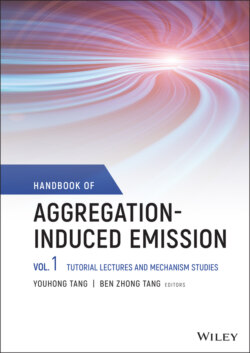Читать книгу Handbook of Aggregation-Induced Emission, Volume 1 - Группа авторов - Страница 15
1.2 Restriction of Intramolecular Motion
ОглавлениеWhen we look into the AIE phenomenon, two essential questions arise: why do the AIEgens show none or weak emission in the solution? Why does the aggregation brighten the light emission of AIEgens? Enthusiastic efforts have been devoted to deciphering the AIE mechanism. Several possible mechanisms have been proposed, including intramolecular conformation planarization, J‐aggregate formation, E/Z isomerization, and excited‐state intramolecular proton transfer, but they are only applicable for specific molecular systems [6c]. A general working mechanism for AIE is highly desired for fundamental understanding and material designing.
Upon absorption of photons, the excited molecule will decay through radiative and nonradiative paths or the photochemical process [2]. Hence, AIEgens in the solution may mainly undergo nonradiative decay or photochemical reaction to dissipate the majority of energy. Once aggregation occurs, the nonradiative decay paths can be blocked, or the radiative paths can be facilitated so that the emission can be enhanced. As the structure determines the property, typical AIEgens own flexible structures, containing multiple rotor or vibrator substituents, like hexaphenylsilole (HPS) and TPE, which endow them with high flexibility and potential to consume energy through intensive intramolecular motion, whereas multiple intermolecular interactions exist in the aggregate state, which can serve as constraints to molecular motions detrimental to the emission [6]. Continuous experimental exploration has been made through manipulation of the molecular motions by adjusting environmental factors, including hydrophobic interaction, temperature, viscosity, pressure, host–guest interaction, and intramolecular constraints such as substituent steric hindrance, ring closing, conjugation effect, and so on [14]. With persistent effort, Tang and coworkers have proposed the restriction of intramolecular rotation (RIR), the restriction of intramolecular vibration (RIV), and, finally, concluded that the restriction of intramolecular motion (RIM) was the general working principle for AIEgens [15].
